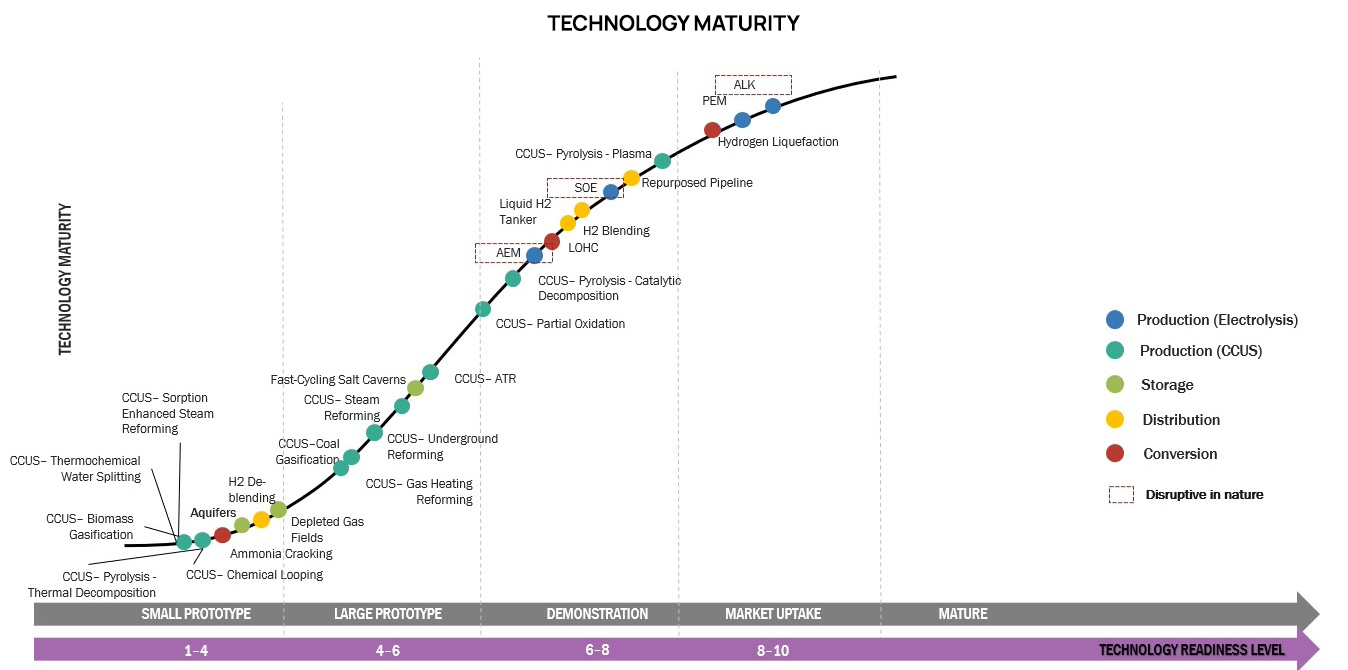OVERVIEW: Green Hydrogen Market worth $7,314 million by 2027 growing at a CAGR of 61.0%. The mobility industry accounted for a share of 58% in terms of value in the Green Hydrogen Market in 2022 and is projected to reach USD 4,550 million by 2027 at a CAGR of 63.4%. The power sector is projected to witness the second highest CAGR of 63.0%, growing from USD 88.5 million in 2022 to USD 1018 million by 2027. During the forecast period, market growth is anticipated to be fueled by elements including declining costs of producing renewable energy from all sources, development of electrolysis technologies, and high demand from FCEVs and the power industry. The global market for green hydrogen is dominated by wind-powered green hydrogen. In the global green hydrogen market, the end-use sector for transportation accounted for the largest market share.
DOWNLOAD PDF: https://www.marketsandmarkets.com/industry-practice/RequestForm.asp
IMPACT OF GREEN HYDROGEN
- Electrolysis: Green hydrogen is primarily created through electrolysis. It involves using an electrical current to divide water (H2O) into hydrogen (H2) and oxygen (O2). There are various forms of electrolysis, such as
- Proton Exchange Membrane (PEM) Electrolysis uses an electrolyte made of solid polymers to separate hydrogen from oxygen. Applications on a smaller scale, like hydrogen refueling stations, are appropriate for it.
- Alkaline Electrolysis: uses an electrolyte made of solid polymers to separate hydrogen from oxygen. Applications on a smaller scale, like hydrogen refueling stations, are appropriate for it.
- Solid Oxide Electrolysis: operates at high temperatures and has a large-scale hydrogen production capacity.
- Renewable Energy Sources: Renewable energy sources, like wind, solar, or hydropower, are used to generate the electricity required for the electrolysis process that creates green hydrogen. These sources are regarded as “green” because they don’t directly emit greenhouse gases.
- Hydrogen Storage: In tanks or as a liquid, hydrogen gas is typically stored and transported under intense pressure. A key component of green hydrogen technology is the creation of effective and secure storage techniques.
- Fuel Cells: Fuel cells are machinery that electrochemically transform hydrogen into electricity. They are employed in numerous processes, such as stationary power generation, stationary backup power systems, and vehicle power. The hydrogen economy relies heavily on fuel cell technology.
- Hydrogen Transportation: Hydrogen fuel cell vehicles (HFCVs), among other forms of transportation, can use green hydrogen. These vehicles emit only water vapor as exhaust and use hydrogen to generate electricity to run electric motors.
- Hydrogen Refueling Stations: The widespread adoption of hydrogen-based transportation depends on the availability of infrastructure for hydrogen vehicle refueling. Vehicles are safely and effectively supplied with high-pressure hydrogen gas at hydrogen refueling stations.
- Hydrogen Production from Biomass: A procedure known as biomass gasification can also be used to produce hydrogen from biomass feedstocks. This technology makes it possible to create green hydrogen from organic materials, further advancing sustainability objectives.
However, there are also some challenges in green hydrogen economy associated with the adoption of green hydrogen, including:
- Cost: Due to the costs of renewable energy sources and electrolysis equipment, producing green hydrogen currently costs more than producing gray hydrogen from fossil fuels. A significant challenge is lowering the price of green hydrogen to make it affordable.
- Energy Efficiency: Electrolysis, the method used to create green hydrogen, is not particularly energy efficient. Hydrogen production is less efficient than other energy storage methods because a significant amount of energy is lost during the process.
- Infrastructure: It is extremely difficult to set up a hydrogen infrastructure that includes facilities for production, transportation, and storage. It will take a lot of work to create a hydrogen distribution network that is comparable to the natural gas infrastructure that already exists.
- Scaling Up Renewable Energy: A significant expansion of renewable energy capacity is required to produce sizable amounts of green hydrogen. In order to do this, problems with intermittent renewable energy, energy storage, and land use must be addressed.
- Market Development: It is extremely difficult to create markets for green hydrogen in sectors of the economy that have historically relied on fossil fuels. It can be challenging to persuade industries to switch to green hydrogen, particularly when doing so requires infrastructure investments.
Technological Developments in Green Hydrogen Production
Technological developments in green hydrogen production are rapidly evolving, driven by increasing demand for clean energy and a growing understanding of the potential of green hydrogen. Here are some of the recent technological developments in green hydrogen production:
- Electrolysis Efficiency: Water is split into hydrogen and oxygen through a process called electrolysis. Proton exchange membrane (PEM) electrolysis and solid oxide electrolysis cells are examples of electrolysis technology advancements that have increased energy efficiency, decreased capital costs, and increased the operational life of electrolyzers.
- Renewable Energy Integration: The integration of renewable energy sources, such as wind and solar power, with electrolysis systems has become more efficient and cost-effective. Electrolyzers can now adapt to the intermittent nature of renewables, allowing for a more reliable and continuous hydrogen production process.
- Hydrogen Storage: It is now more practical to store and transport hydrogen thanks to advancements in technologies for safe and effective hydrogen storage, such as metal hydrides and carbon-based materials.
- Carbon Capture and Utilization: Carbon capture and utilization (CCU) technologies are used in some environmentally friendly hydrogen production processes, making it possible to produce hydrogen with zero carbon emissions.
- Green Hydrogen Production at Scale: Larger-scale green hydrogen production projects are currently being developed, which will further reduce costs and show the green hydrogen’s commercial viability.
Read More: https://www.marketsandmarkets.com/industry-practice/hydrogen/green-hydrogen
- Leading players in Green Hydrogen Economy
- Strengths and limitations of green hydrogen
- Green hydrogen technologies
- Hydrogen as clean energy
- Green hydrogen energy solutions





